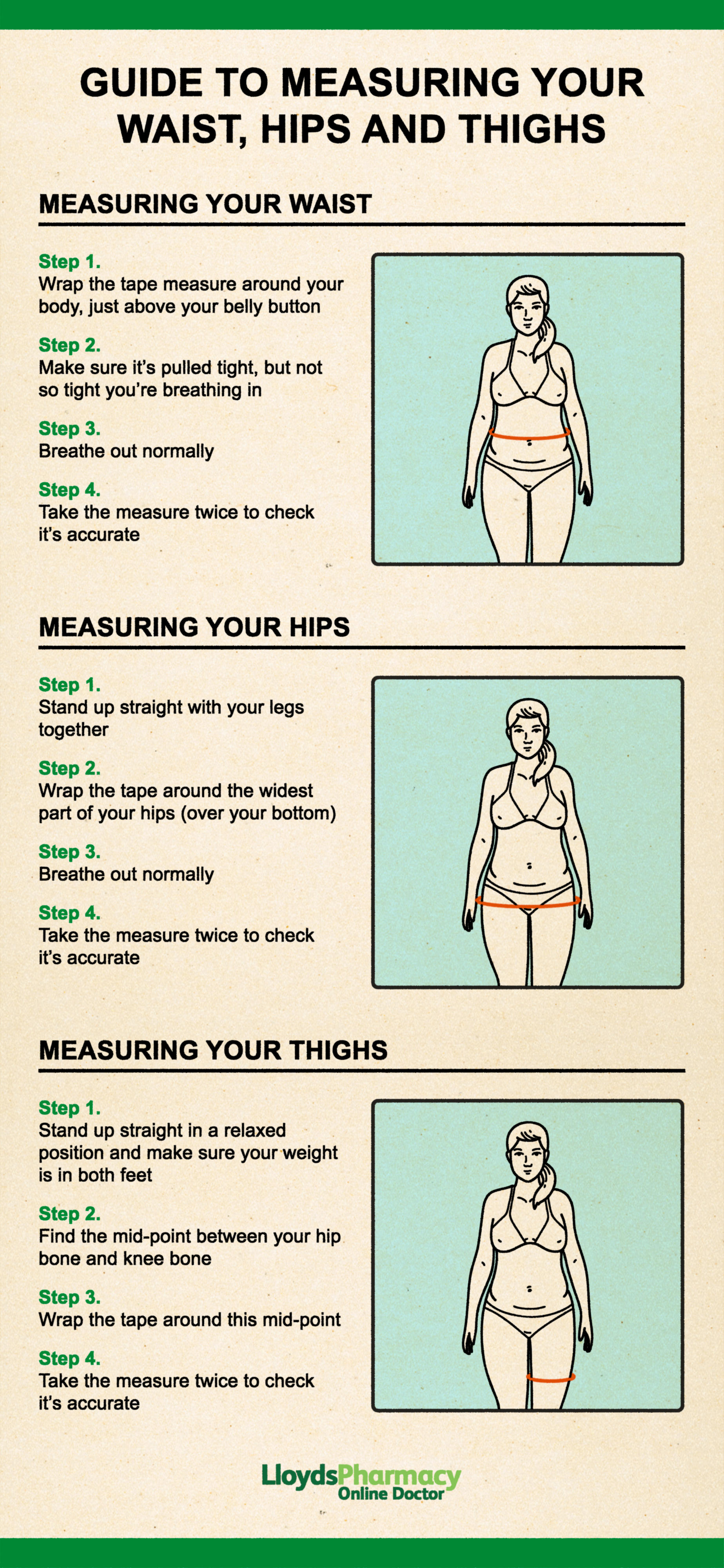Keeping track of your waist, hip and thigh measurements
Reviewed by our clinical team
When you’re trying to lose weight it’s easy to become fixated on the number on the weighing scales, and it’s not always the number you want to see. But did you know when you’re trying to lose weight, it’s a good idea to also keep track of some of your other measurements – like the circumference of your waist, hips and thighs?
In this article we’re going to looks at why these dimensions are important, what your waist measurement might be telling you and how you can measure yourself accurately.
Why should you take measurements of your waist hip and thighs?
When you’re on a weight loss plan, it’s normal to find weeks when you don’t lose any weight, and it can be disheartening. There are lots of reasons you might not have lost weight and one of them might be that your body shape is changing. If you’ve been exercising a lot, you might find you’ve built some muscle, and muscle tends to be denser than fat, so weigh more. By keeping track of other measurements like your waist, hips and thighs you might see these getting smaller, as your body gets leaner, and hopefully this will keep you motivated.
Why does waist size matter?
Keeping track of your waist measurements can help you make sure you’re not running the risk of certain health conditions. Carrying weight around your waist can increase your risk of heart disease, type 2 diabetes and having a stroke, this risk increases further for people of African Caribbean, South Asian, Chinese and Japanese origin.
Even if you have a ‘healthy’ weight according to your body mass index (BMI), you might still be carrying fat around your stomach, which you should try to lose if you can.
There are two types of fat you might carry around your waist – subcutaneous fat and visceral fat. Subcutaneous fat is stored just under the skin, and you can feel it. Visceral fat is stored deep inside the body and forms around organs. It’s this kind of fat that tends to be the most dangerous because it creates toxins in the body, including cytokines - a type of toxin that raises your risk of heart disease and makes your body less reactive to insulin. There is also some evidence that this type of fat can potentially increase risk of certain diseases in cancers.
Healthy waist measurements
These days, the official advice on a healthy waist is for it to be less than half of your height. This is known as your waist to height ratio. For example, if you’re 160cm tall, your waist should be less than 80cm.
The NHS also advises that regardless of your height or age, you should try and lose weight if your waist measurement is:
- 94cm or more for men
- 80cm or more for women
Should I also keep track of my hip and thigh measurements?
Your hip and thigh measurements might not tell you as much about your health as your waist measurement, but they’re useful for keeping track of your progress when you’re on a weight loss journey.
Does my waist to hip ratio matter?
You can also use your waist to hip ratio as an indicator of whether you need to lose some weight around your middle. Generally, if your waist is bigger than your hips you might find that you’re carrying fat around your tummy.
To calculate your waist to hip ratio you simply divide your waist measurement by your hip measurement. For example, if your waist is 50cm and your hips are 70cm, your waist to hip ratio would be 0.71.
For women, a waist to hip ratio bigger than 0.85 puts you at greater risk of some conditions. For men, it’s anything bigger than 1.00.
Guide to measuring your waist, hips and thighs
Taking these measurements is very simple, you can get someone to help you or do it on your own. All you need is a tailor’s tape measure (not the ones you use for DIY).
Measuring your waist
Find the space between the bottom of your ribs and the top of your hips
- Wrap the tape measure around this area of your body, just above your belly button
- Make sure it’s pulled tight, but not so tight you’re breathing in
- Breathe out normally
- Take the measure twice to check it’s accurate
Measuring your hips
- Stand up straight with your legs together
- Wrap the tape around the widest part of your hips (over your bottom)
- Breathe out normally
- Take the measure twice to check it’s accurate
Measuring your thighs
- Stand up straight in a relaxed position
- Make sure your weight is in both feet
- Find the mid-point between your hip bone and knee bone
- Wrap the tape around this mid-point
- Take the measure twice to check it’s accurate

Help with losing weight
Here at Online Doctor, we’re here to help you wherever we can while you’re on your weight loss journey. If you’re looking for advice, we have a whole library of weight loss and lifestyle articles from our clinicians.
We also have a number of medicated weight loss treatments such as Mounjaro® and Wegovy®, which when combined with a reduced calorie diet and increased activity, can give your body the extra support it needs to lose weight. Read our guide to medicated weight loss here.
References
https://www.nhs.uk/live-well/healthy-weight/bmi-calculator/
https://patient.info/news-and-features/what-your-waistline-says-about-your-health
https://www.bhf.org.uk/informationsupport/heart-matters-magazine/medical/measuring-your-waist
https://elht.nhs.uk/services/dietetics/body-measuring-techniques





